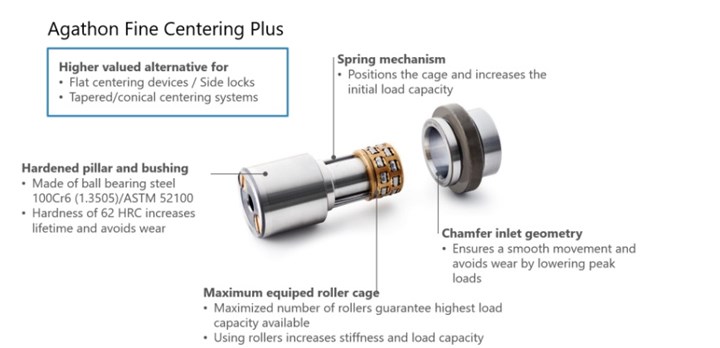WEBINAR: Roll Don’t Slide: Flexibility and Reduced Wear Are Key Benefits to New Guiding and Centering Systems
A free webinar takes a look at guiding and centering system options for injection molds that lengthen mold life and save money, among other benefits.
#education

When it comes to selecting the next guiding system, fine centering system, or ejector guiding components for your injection molds, this breakdown of alternative approaches presented by Agathon’s Christoph Meier, Engineering Manager—Special Project Applications and Bob Dionne, North American, Sales and Product Manager for Standard Products may help.
Here are just a few of the discussion points from this free webinar:
- The difference between sliding vs. rolling guides.
- The advantages and disadvantages of friction guides and anti-friction guides/rolling elements.
- True cost considerations (wear, reduced maintenance considerations)
- Alternative guiding systems can address common mold builder challenges, including shrinking profit margins (due to expensive maintenance and too many part rejects); planning reliability (time pressure, spare parts availability); higher productivity (parts per shot, speed); and upgrades that are hard to realize due to rework, etc.
- Conventional guiding and centering concept vs. a new guiding system with a rolling bushing system: One system guides and centers parting line without backlash.
- A combined guiding and centering system with a flexible guiding system off the shelf.
- Key features: profile rollers; free space to add more mold inserts to increase productivity; flexible collar retaining ring can be positioned individually, and one item can be used for several plate thicknesses; long centering stroke and a flexible collar concept that means only one system required in stock for higher operational reliability.
- Fine centering system is a cost-efficient alternative to a side lock, flat-centered device, or tapered/conical centering system.
- Offers flexibility as the mold builder is not beholden to using 4; you can 2,3, 4, 5, or however many you need; uses a spring mechanism, hardened pillar and bushing, chamfered inlet geometry, fully equipped roller cage.
- Ejector guides require little maintenance, and reduce wear on ejectors.

Below are some of the attendee questions asked during the Q&A portion of the webinar after a rundown of several application examples:
- How precise do the plate bores need to be held? Is there a suggested location tolerance?
- What is the difference between the Agathon roller and the Profile roller, and why would I choose one over the other?
- If we use the mini-guides without the bushings, will a wire EDM finish be acceptable for the hole?
- On the Guide System Plus, what exactly is the L5 max, and why is it so important?
- There are a number of different Fine Centering Plus styles and sizes. How do I select the right one
- You mentioned that I could use the Fine Centering Mini with or without a bushing. How do I determine whether or not that I should use a bushing?
- How fast can the guides on the ejector system run?

In a nutshell, featured anti-friction guiding units can be used in a variety of ways in a mold, yield long service life, require low maintenance and no tilting of plates, offer wear protection, high-precision, backlash-free centering, improved part quality, and precise and simultaneous closing movement of all hot runner needles, as well as special designs for columns, bushings, and ball or roller cages.
To watch this full Agathon webinar for free, click here. And to view all archived webinars, click here.
RELATED CONTENT
-
Quick Math for Cylinder Calculations
Simple cylinder calculations provide good first look comparisons for proper sizing when moldmakers are considering the most suitable side-action option early in the mold design.
-
Automated In-Mold Marking for Plastic Injection Mold Tools
The importance of plastic part traceability and how to achieve it.
-
Alt Method of Actuating Injection Mold Core Pulls and Slides
Improve efficiency and speed with hydraulic locking core pull cylinders.










